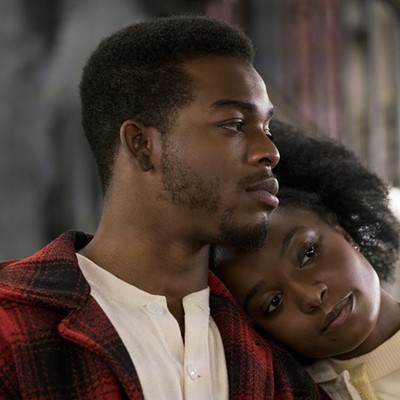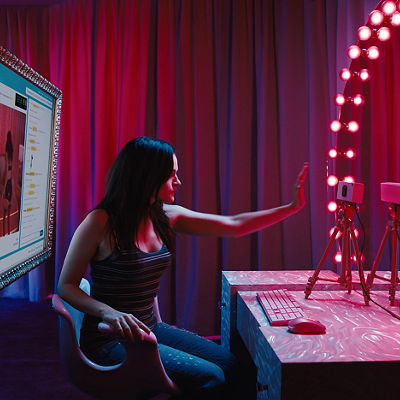Given that Ready to Wear, set within the world of Parisian haute couture, sends up the fashion industry, it's understandable -- if not exactly expected -- that Altman would be concerned with his physical appearance. Proud of himself, he announces, "If somebody says, 'Come on over and wear your old clothes,' I can't go, I don't have any old clothes."
Clothes, of course, figure largely in Ready to Wear. Leading designers allowed Altman to shoot their fall 1994 fashion shows as backdrops for the movie; some even appear on film as themselves, among them Sonia Rykiel, who Altman cites as his inspiration for the movie. Altman first met Rykiel ten years ago at one of her shows and was so bowled over by the spectacle that he knew he had to use it as the basis for a movie. "The majority of the designers are truly artists," Altman says, pointing out that he admires them partly for their showmanship and partly for their stamina because "the minute they finish their product, they're onto something else. They have to change what they did before. Even if what they did they think is the best thing they ever did, they all say, 'I have to do something different now' to actually erase that."
That wouldn't be a bad way to describe Altman's approach to his work either. A 1970s directing idol who churned out groundbreaking film after groundbreaking film from M.A.S.H. to McCabe and Mrs. Miller to The Long Goodbye to Nashville, for almost a decade he seemed to disappear from the minds of moviegoers. Following the 1980 disaster of Popeye, Altman settled down to make some half-dozen film adaptations of plays by such writers as Harold Pinter and Sam Shepard. Though he was never without work, Altman rarely had much of an audience. Then as the '90s began he seemed to catch on again, first with a well-regarded look at Vincent van Gogh and his brother, and then with the critical hits The Player and Short Cuts.
Both of those films went back to what many consider Altman's main strength, and his main contribution to the art of filmmaking: ensembles, improvisation, overlapping dialogue, multiple and interconnecting story lines, a documentary feel and cameras that roam and eavesdrop to create something that seems real, less than real and more than real all at once.
Younger filmmakers over the years have definitely gone to school on Altman, with even the likes of television (Hill Street Blues and E.R., most notably) copying his style. But it wasn't until recently that he appeared willing to take back that style himself, and it's that seems-to-be-real, ensemble approach that's on screen again in Ready to Wear. While it might seem that Altman wouldn't have been happy watching others co-opt his ideas while he wandered in the filmic wilderness, he says he never minded his imitators. It was their validation of him, Altman says, that gave him the freedom to continue making films the way he wanted. "The kids who are making decisions now and who are actually handing me the money to make these things now look at the whole history of what I've done," says Altman. "They have a different look at it than Jack Warner had. It gives me a chance to continue to be experimental."
Ready to Wear, he says, continues that experimental track, with its mix of what's real and what's not. In the film, for instance,
Kim Basinger plays a ditsy fashion reporter who works for "FAD-TV," which, though it sounds like it's made up, is an actual television channel -- the Fashion And Design channel -- that, at the time of filming, had all its logos and equipment in order but had not yet gone on the air. Letting Altman use it gave the fledgling channel publicity, while it gave Altman, he says, "more reality than if we made up a channel."
Perhaps not so experimental at this point, but still distinctly Altman, was the director's decision to allow his large -- 30-plus character -- cast to become involved in the creative process, depending on them to create their own characters and, in some cases, dialogue. This was not always a plus, admits Sally Kellerman, who's worked with Altman on a number of pictures. The problem, Kellerman says, is that "if you don't think of something clever, you won't make the cut." Or, as Anouk Aimee remarks, likening Altman to Fellini, "You can do what you want, but you end up doing what he wants." When asked about this fight for screen space -- a fight in which there's a real possibility that, by the time editing is done, some of the talent could end up with merely one line of dialogue, or none -- Altman is philosophic.
"Well, it's a problem," he admits. "Most of these people are used to being at least a costar or a featured player in movies. And they come into this one, and the first two or three weeks everybody was like an extra because we were going to the actual fashion shows and we put microphones on all these people and tape recorders in their pockets and I said, 'You have to be in character all the time because you never know when the camera will be on you or is not going to be on you.' And they'd all ride to work on the bus and they'd share the same dressing room, with sheets set up between their cots. It was a new experience for them. So, sure, it made them nervous." Altman smiles faintly when he adds that "by putting that many people together, they tend to police themselves. Nobody wants to be the bad guy. So you don't see any big flares of temper about 'I want my dressing room over here.' It's like going to camp, I guess."
Now that camp's over, Altman has some others things on his mind, such as Kansas City, a movie he's planning to do on jazz in the Midwest in the 1930s. "I'm going into a whole new kind of technique," he says enthusiastically, and then shies away from explaining what that "new technique" is because, he admits, he hasn't quite worked it out yet. He does, however, say that it will involve still photography of the type Ken Burns used in his documentary The Civil War. But with this difference: Altman will be making the stills. The stills will be woven into the movie, and, he hopes, "give a sense of reality that hasn't been in film before."
"When you see them," he says, "it's going to give you the sense memory or the illusion that, oh!, these must have been taken at this time."
Kansas City will start shooting next April. After that, Altman plans to direct the movie version of Angels in America, shooting both parts as one picture and then releasing them both within a few weeks of each other. The idea is for both parts to play simultaneously at movie theaters.
Whether that will cause as much stir as the much-publicized climax of Ready to Wear -- a fashion show featuring a runway of actual supermodels who sport what the film satirically calls "the most revolutionary new look" in ready-to-wear that was ever created: complete nakedness -- is unlikely. But Altman brushes off suggestions that his ending was meant merely to shock (though it did surprise much of the cast in attendance, who had no idea what they were being prepared to witness).
"The film would have been easily forgotten and would just be a farce had we not had this ending," Altman insists. "And I wouldn't have made the film without this ending. To me, it gave it a real reason for being. I think it makes the difference of it being a film that will have some lasting value and will endure rather than just being pure farce. It raises the stakes; it applies to everything that happened before or everything that happened before applies to it .... All of the stories deal with what we wear or with nakedness, what we wear, what we don't wear. And the final act is this nakedness, and that's why we wear clothes: to hide our nakedness.





